2019 MERCEDES-BENZ SLC ROADSTER ECU
[x] Cancel search: ECUPage 45 of 306
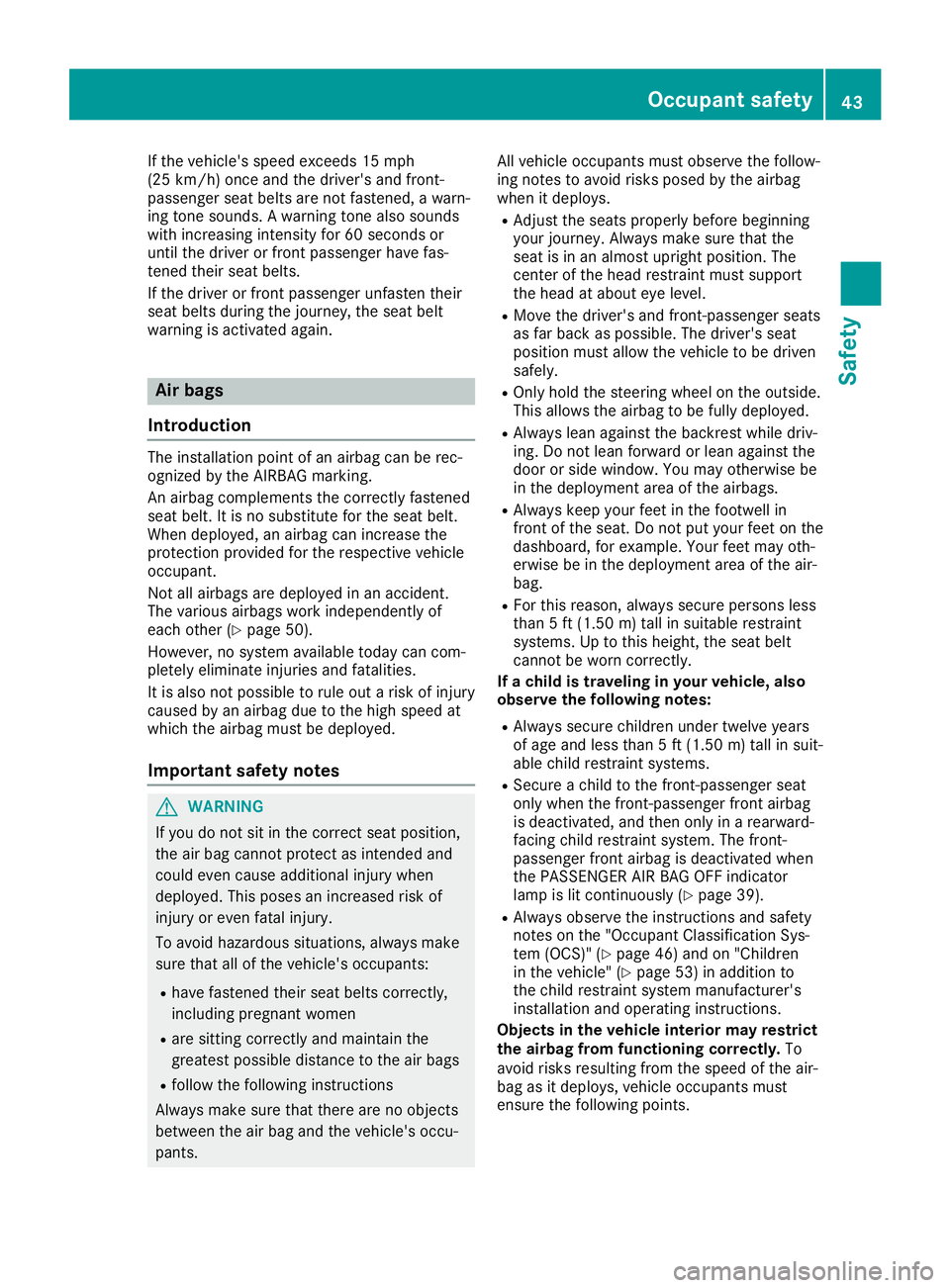
If
the vehicle 'sspeed exceeds 15mph
(25 km/h) onceandthedriver's andfront-
passe ngerseatbelts arenot fastened, awarn-
ing tone sounds. Awarning tonealsosounds
with increasing intensityfor60seconds or
until thedriver orfront passe ngerhave fas-
tened theirseatbelts.
If the driver orfront passe ngerunfasten their
seat belts duringthe journey, theseat belt
warning isactivated again. Air
bags
Introductio n The
installa tionpoint ofan airb agcan berec-
ognized bythe AIRBAG marking.
An airb agcomplements thecorrectly fastened
seat belt. Itis no substitu tefor the seat belt.
When deployed ,an airb agcan increase the
protection providedfor the respective vehicle
occupant.
Not allairb ags aredepl oyed inan accident.
The variou sairb ags work indepe ndently of
each other (Ypage 50).
However, nosystem availabletoday cancom-
pletel yelimi nate injuries andfatali ties.
It is also notpossib leto rule outarisk ofinjury
cause dby an airb agdue tothe high speed at
which theairbagmust bedepl oyed .
Important safetynotes G
WARNING
If you donot sitinthe correct seatpositio n,
the airbag cannot protect asintended and
could evencause additional injurywhen
depl oyed .This poses anincreased riskof
injury oreven fatalinjury.
To avoid hazardo ussitua tions, always make
sure thatallofthe vehicle 'soccupants:
R have fastened theirseatbelts correctly,
includi ngpregnant women
R are sitting correctly andmaintain the
greatest possibledistance tothe airbags
R follow thefollow inginstructions
Alway smake surethatthere arenoobjects
betwee nthe airbag and thevehicle 'soccu-
pants. All
vehicle occupants mustobserve thefollow -
ing notes toavoid risksposed bythe airbag
when itdepl oys.
R Adjust theseats properl ybefore beginning
you rjourney. Alwaysmake surethatthe
seat isin an almos tupri ghtpositio n.The
center ofthe head restraint mustsupport
the head atabou teye level .
R Move thedriver's andfront-passenger seats
as far back aspossib le.The driver's seat
positio nmust allow the vehicle tobe driven
safel y.
R Only holdthesteering wheelonthe outsid e.
This allows theairbagtobe fullydepl oyed .
R Alway slea naga inst thebackrest whiledriv-
ing. Donot leanforward orlea naga inst the
door orside window .You may otherwise be
in the depl oyment areaofthe airbags.
R Alway skeep yourfeet inthe footwell in
front ofthe seat. Donot putyourfeet onthe
dashb oard,forexample .Your feetmay oth-
erwis ebe inthe depl oyment areaofthe air-
bag.
R For this reason, always secure persons less
than 5ft (1.50 m)tall insuita blerestraint
systems. Uptothis heigh t,the seat belt
cannot beworn correctly.
If achil dis traveling inyour vehic le,also
obse rvethe followi ngnotes:
R Alway ssecure childrenunder twelve years
of age and less than 5ft (1.50 m)tall insuit-
abl echild restraint systems.
R Secure achild tothe front-passenger seat
only when thefront-passenger frontairbag
is deactiva ted,andthen onlyinarearwa rd-
facing childrestraint system.Thefront-
passe ngerfront airbagisdeactiva tedwhen
the PASSENGER AIRBAG OFFindicator
lamp islit continuously (Ypage 39).
R Alway sobserve theinstructions andsafety
notes onthe "Occupa ntCla ssifica tionSys-
tem (OCS)" (Ypage 46)and on"Ch ildre n
in the vehicle "(Y page 53)inaddi tion to
the child restraint systemmanufacture r's
installa tionandopera tinginstructions.
Objects inthe vehic leinterio rmay restrict
the airbag fromfunctio ningcorrec tly.To
avoid risksresultingfrom thespeed ofthe air-
bag asitdepl oys, vehicle occupants must
ensure thefollow ingpoints. Occ
upant safety
43Safety Z
Page 49 of 306
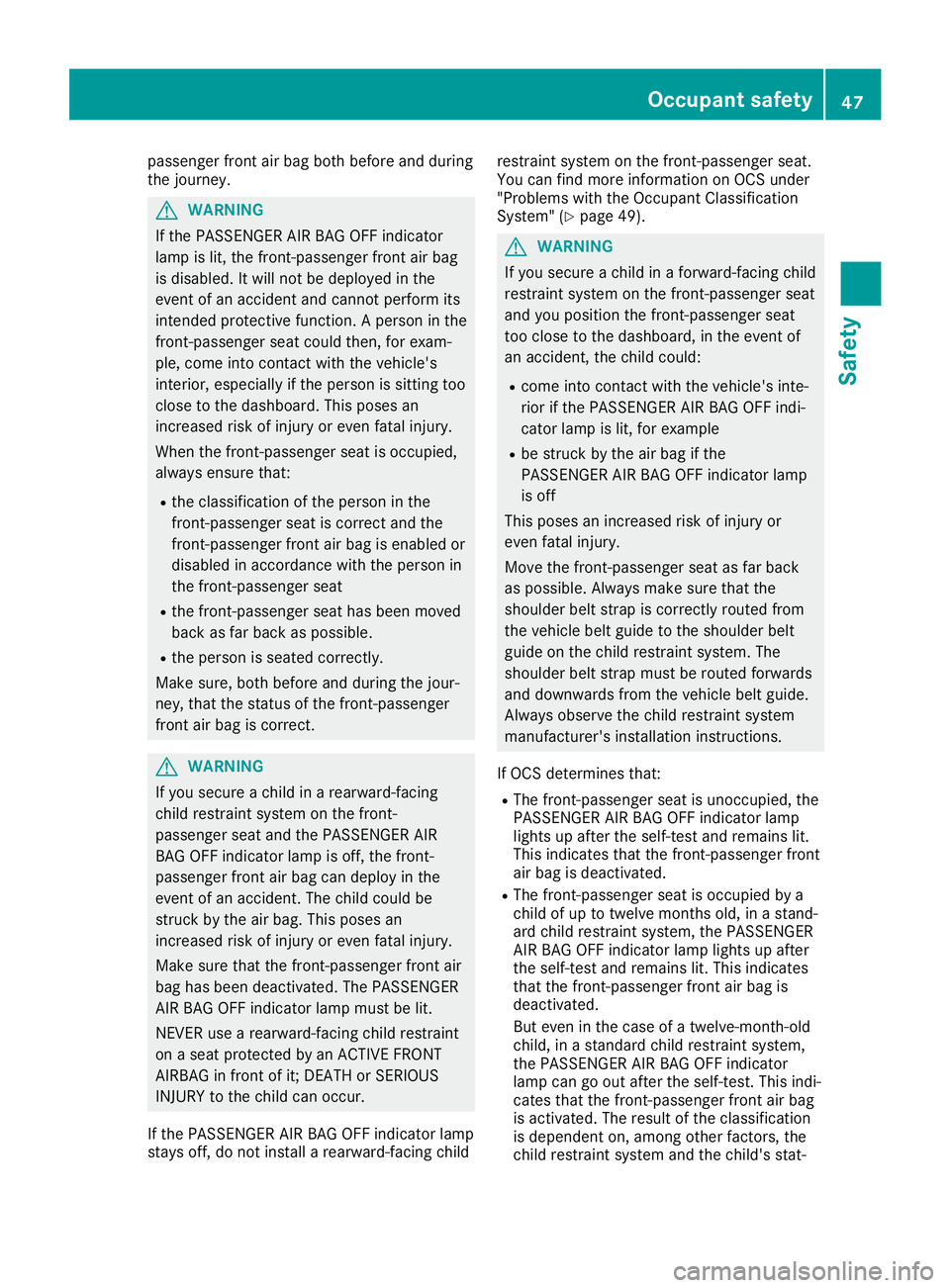
passenger
frontair bag both before andduring
the journ ey. G
WARN
ING
If the PAS SENGER AIRBAGOFF indicat or
lamp islit, the fron t-passenger frontair bag
is disabled. Itwill notbedeployed inthe
event ofan acciden tand cann otperfor mits
int ended protective func tion.A person inthe
fron t-passenger seatcould then,for exam-
ple, come intocon tact with thevehicle's
int erior, especially ifthe person issitt ing too
close tothe dashboard. Thisposes an
incr eased riskofinjury oreven fatalinjury.
When thefron t-passenger seatisocc upied,
always ensure that:
R the classific ationofthe person inthe
fron t-passenger seatiscorr ectand the
fron t-passenger frontair bag isenabled or
disabled inaccor dance withtheperson in
the fron t-passenger seat
R the fron t-passenger seathasbeen moved
back asfar back aspossible.
R the person isseated correctly.
Make sure,bothbefore andduring thejour-
ney, thatthestatusofthe fron t-passenger
fron tair bag iscorr ect. G
WARN
ING
If you secure achild inarearward-f acing
child restraint system onthe fron t-
passenger seatandthePAS SENGER AIR
BA GOFF indicat orlamp isoff, thefron t-
passenger frontair bag candeploy inthe
event ofan acciden t.The child could be
str uck bythe airbag. Thisposes an
incr eased riskofinjury oreven fatalinjury.
Make surethatthefron t-passenger frontair
bag hasbeen deactiv ated.ThePASSENGER
AIR BAGOFF indicat orlamp must belit.
NEV ERuse arearward-f acingchildrestraint
on aseat prote cted byan ACTIVE FRONT
AIRB AGinfron tof it;DE ATH orSERIOUS
INJURY tothe child canoccur.
If the PAS SENGER AIRBAGOFF indicat orlamp
stays off,donot installarearward-f acingchild rest
raint system onthe fron t-passenger seat.
You canfind more information onOCS under
"Problems withtheOcc upant Classification
System "(Y page 49). G
WARN
ING
If you secure achild inaforward- facingchild
rest raint system onthe fron t-passenger seat
and youposition thefron t-passenger seat
too close tothe dashboard, inthe event of
an acciden t,the child could:
R come intocon tact with thevehicle's inte-
rior ifthe PAS SENGER AIRBAGOFF indi-
cator lampislit, for example
R be struck bythe airbag ifthe
PAS SENGER AIRBAGOFF indicat orlamp
is off
This poses anincr eased riskofinjury or
even fatalinjury.
Move thefron t-passenger seatasfar back
as possible. Alwaysmakesurethatthe
shoulder beltstrap iscorr ectlyrouted from
the vehicle beltguide tothe shoulder belt
guide onthe child restraint system. The
shoulder beltstrap must berouted forwards
and downwards fromthevehicle beltguide.
Always observe thechild restraint system
manufact urer'sinstallation instruct ions.
If OCS determ inesthat:
R The front-passenger seatisunocc upied, the
PAS SENGER AIRBAGOFF indicat orlamp
lights upafter theself-t estand remains lit.
This indicat esthat thefron t-passenger front
air bag isdeactiv ated.
R The front-passenger seatisocc upied bya
child ofup totwelve monthsold, inastan d-
ard child restraint system, thePAS SENGER
AIR BAGOFF indicat orlamp lights upafter
the self-t estand remains lit.This indicat es
that thefron t-passenger frontair bag is
deactiv ated.
But even inthe case ofatwelve- month-old
child, inastan dard child restraint system,
the PAS SENGER AIRBAGOFF indicat or
lamp cangoout after theself-t est.This indi-
cates thatthefron t-passenger frontair bag
is activ ated. Theresult ofthe classific ation
is dependen ton, among otherfactors, the
child restraint system andthechild's stat- Occupant
safety
47Safet y Z
Page 55 of 306
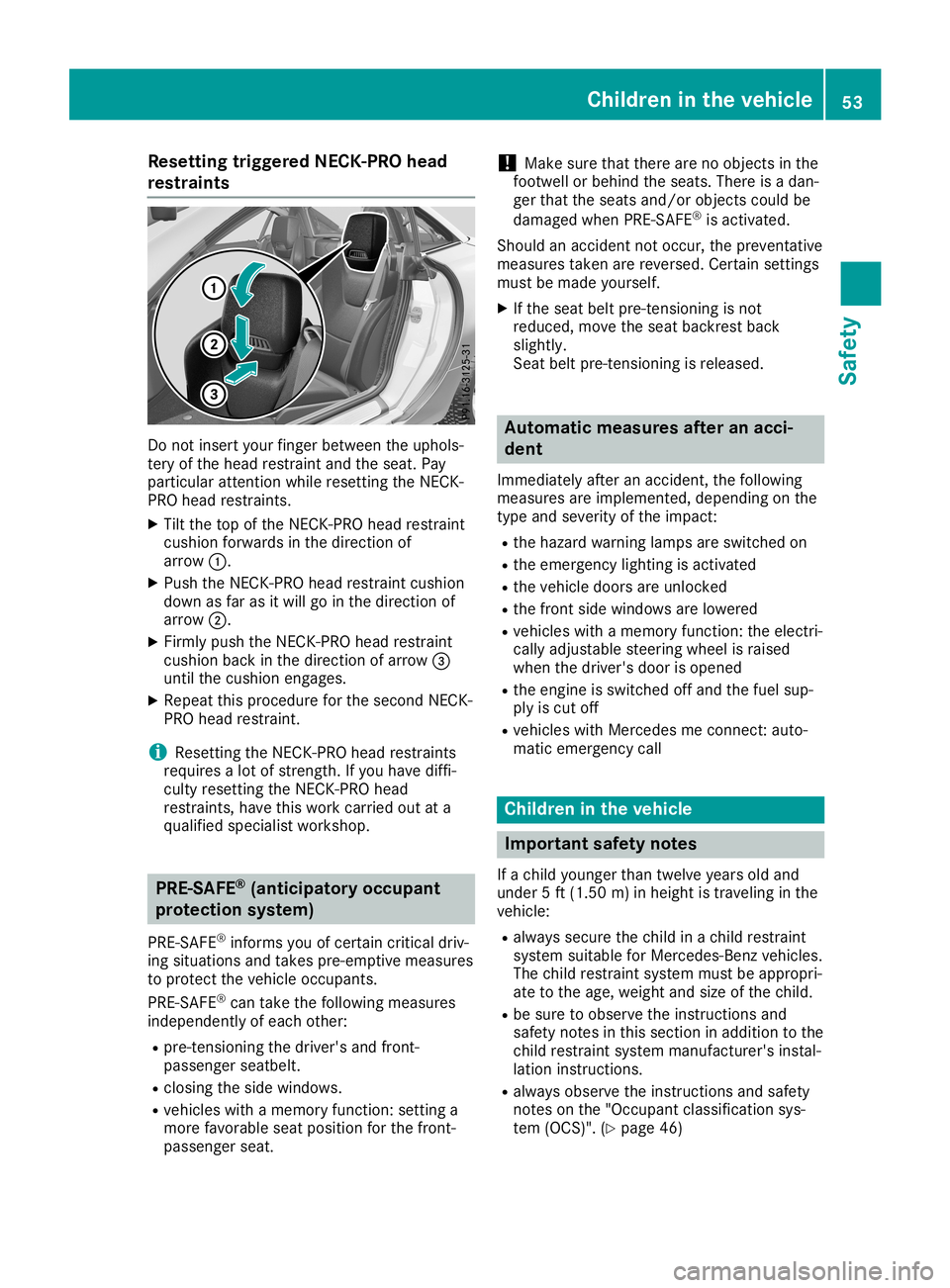
Res
ettingtrigg eredNEC K-PRO head
res traints Do
not inse rtyo ur fing erbetw eentheuphol s-
tery ofthe headres trai ntand theseat.Pa y
pa rticu larattenti onwhile res etting theNECK -
PR Ohea dres trai nts.
X Tilt the top ofthe NECK -PROhea dres trai nt
cus hionforw ardsin the directi onof
arr ow 0043.
X Pu sh the NECK -PROhea dres trai ntcus hion
dow nas far asitwi llgo inthe directi onof
arr ow 0044.
X Firm lypu sh the NECK -PROhea dres trai nt
cus hionba ck inthe directi onofarr ow 0087
unti lthe cushionenga ges.
X Re pea tthis proced ure forthe seco ndNECK -
PR Ohea dres trai nt.
i Re
setti ngthe NECK -PROhea dres trai nts
req uires alotof streng th.Ifyo uha ve diffi-
cul tyres etting theNECK -PROhea d
res trai nts, have this workcarr ied ou tat a
qu alifi ed spe cialist wo rksho p. PRE
-SAFE®
(an ticipato ryoccupa nt
prote ction sys tem)
PR E-SAFE ®
info rms youof certa incriti caldriv-
ing situ ations and take spre -emp tivemea sures
to pro tect thevehicleoccu pants.
PR E-SAFE ®
can take thefollowi ng mea sures
ind epe ndentl yof each othe r:
R pre -tensi oning thedriver' sand front-
pa sse nger seatbel t.
R clo sing thesidewi ndow s.
R veh icles with amemo ryfuncti on:setti nga
more favora ble sea tpos ition for the front-
pa sse nger seat. !
Ma
kesure that there arenoobje ctsinthe
foo twe llor beh indthe seats.The reisada n-
ger that theseatsand /or obje ctscou ldbe
da mag edwhen PRE-SAFE ®
is acti vate d.
Shou ldan acci dent notoccu r,the preventa tive
mea sures take nare reve rsed.Ce rtai nsetti ngs
mus tbe mad eyo urs elf.
X Ifthe seatbel tpre -tensi oning isnot
red uce d,move theseatba ckrest back
sli ghtl y.
Sea tbel tpre -tensi oning isrel eased . Auto
matic measuresafter anacc i-
den t
Imme diate lyafte ran acci dent, thefollowi ng
mea sures are implemente d,dep endi ngon the
typ eand severityof the impact:
R the hazard warning lamps areswitched on
R the eme rgency lighti ngisacti vate d
R the vehicledoo rsare unlocked
R the front sidewi ndow sare lowe red
R veh icles with amemo ryfuncti on:the electri -
cal lyad justa ble stee ring wheel israi sed
wh en the driver' sdoo ris ope ned
R the engi neisswi tched offand thefuelsu p-
pl yis cut off
R veh icles with Mer cedesme connect: auto-
mati ceme rgency call Chi
ldre nin the vehic le Impo
rtant safetynotes
If achi ldyoung erthan twelveyears old and
und er5ft (1.50 m)inhe ight istra vel ing inthe
veh icle:
R alwa yssecur ethe childinachi ldres traint
sy ste msuita ble for Merced es-Benz vehicles .
The childres traint syste mmu stbe appro pri-
ate tothe age, we ight and size ofthe child.
R be sure to observe the instructio nsand
sa fety note sin thi sse ctio nin ad ditio nto the
chi ldres traint syste mma nuf actu rer'sins tal-
la tio nins tructio ns.
R alwa ysobserve the instructio nsand safety
note son the "Occu pant cla ssificati on sys-
tem (OCS) ".(Y page 46) Ch
ildren inthe vehic le
53Safe ty Z
Page 56 of 306
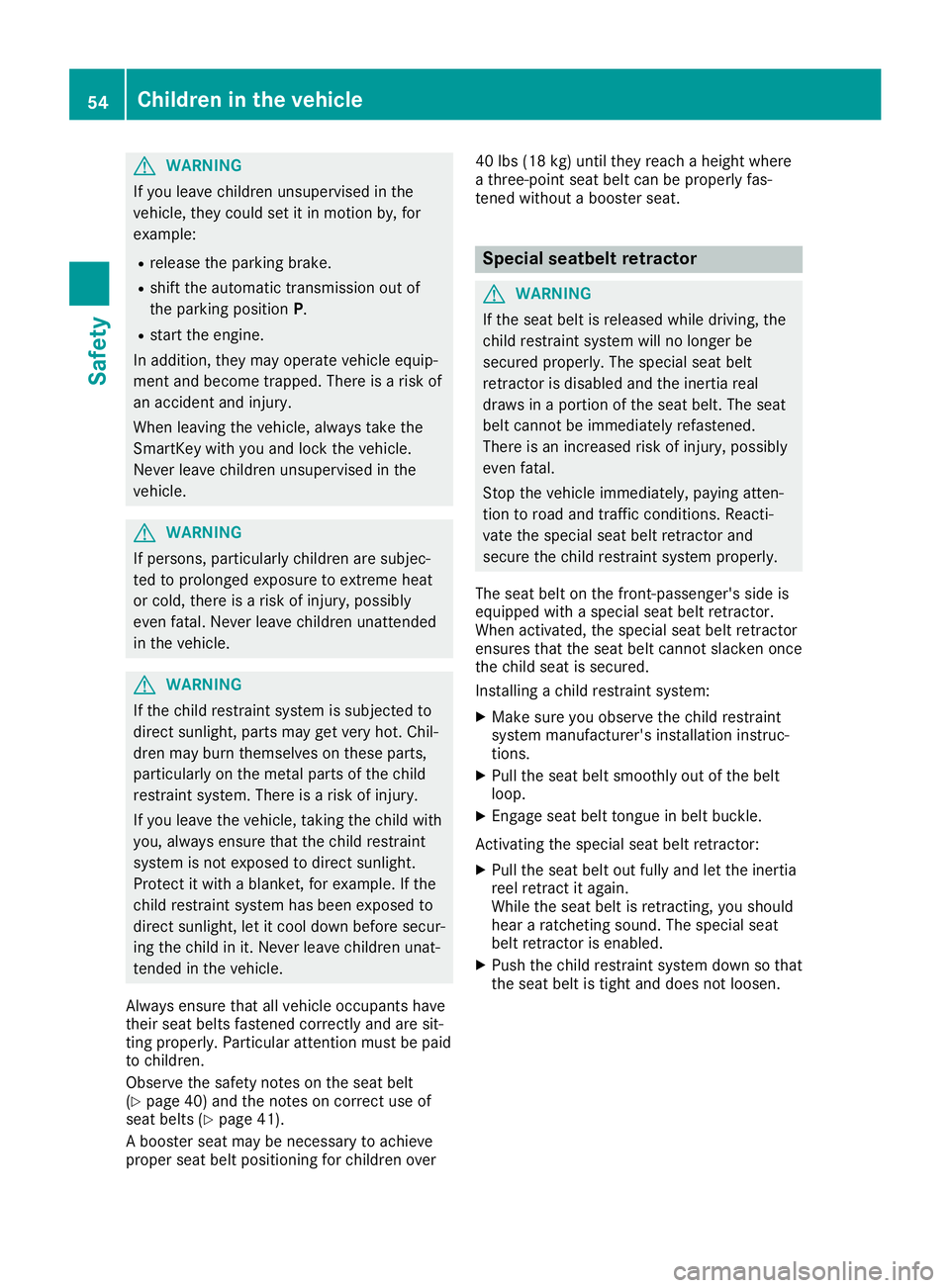
G
WARNING
If you leavechild renunsu pervi sedinthe
vehicl e,they couldset itin motion by,for
exampl e:
R rele ase theparki ngbrake.
R shift theautomatic transmissi onout of
the parki ngposi tion P.
R start theengine.
In add ition, theymayopera tevehicl eequ ip-
ment andbecome trapped.There isarisk of
an accide ntand injury .
When leaving thevehicl e,alw aystake the
SmartKey withyouand lock thevehicl e.
Never leavechild renunsu pervi sedinthe
vehicl e. G
WARNING
If perso ns,particu larlychild renaresubjec-
ted toprolo nged exposu reto extreme heat
or cold, there isarisk ofinjury ,possi bly
even fatal.Never leavechild renunattended
in the vehicl e. G
WARNING
If the child restrai ntsystem issub jected to
dire ctsunli ght,parts maygetvery hot.Chil-
dren mayburn themsel vesonthese parts,
particu larlyon the metal partsofthe child
restrai ntsystem. Thereisarisk ofinjury .
If you leavethe vehicl e,taking thechild with
you ,alw aysensure thatthechild restrai nt
system isnot expose dto dire ctsunli ght.
Protect itwith abla nket, forexampl e.Ifthe
child restrai ntsystem hasbeen expose dto
dire ctsunli ght,letitcool downbefore secur-
ing the child init. Never leavechild renunat-
tended inthe vehicl e.
Alwa ysensure thatallvehicl eoccupa ntshave
their seatbeltsfastened correctly andaresit-
ting prope rly.Particu larattention mustbepaid
to child ren.
Observe thesafety notesonthe seat belt
(Y pag e40) and thenotes oncorrect useof
seat belts(Y pag e41).
A booster seatmaybenecessa ryto achie ve
prope rseat beltposi tioning forchild renover 40
lbs (18 kg)until theyreach aheig htwhere
a three-poi ntseat beltcan beprope rlyfas-
tened withoutabooster seat. Spec
ialseatbe ltretractor G
WARNING
If the seat beltis rele ased whiledrivi ng,the
child restrai ntsystem willno longer be
secure dprope rly.The speci alseat belt
retractor isdisa bledand theinertia real
draw sin aportion ofthe seat belt.The seat
bel tcannot beimmed iatelyrefastene d.
There isan increas edrisk ofinjury ,possi bly
even fatal.
Stop thevehicl eimmed iately,pay ing atten-
tion toroad andtraffic conditions. Reacti-
vate thespeci alseat beltretractor and
secure thechild restrai ntsystem properly.
The seat belton the front-passenge r'sside is
equ ipped with aspeci alseat beltretractor.
When activated,thespeci alseat beltretractor
ensure sthat theseat beltcannot slacken once
the child seatissecure d.
Install ingachild restrai ntsystem:
X Make sureyouobser vethe child restrai nt
system manufacturer's installationinstruc-
tions.
X Pul lthe seat beltsmoothly outofthe belt
loop .
X Engage seatbelttongue inbel tbuckle .
Activating thespeci alseat beltretractor:
X Pul lthe seat beltout fullyand letthe inertia
reel retract itaga in.
Whil ethe seat beltis retracting, youshou ld
hear aratcheting sound.The speci alseat
bel tretractor isenabl ed.
X Push thechild restrai ntsystem downso that
the seat beltis tight anddoes notloos en. 54
Chi
ldren inthe vehi cleSafety
Page 57 of 306
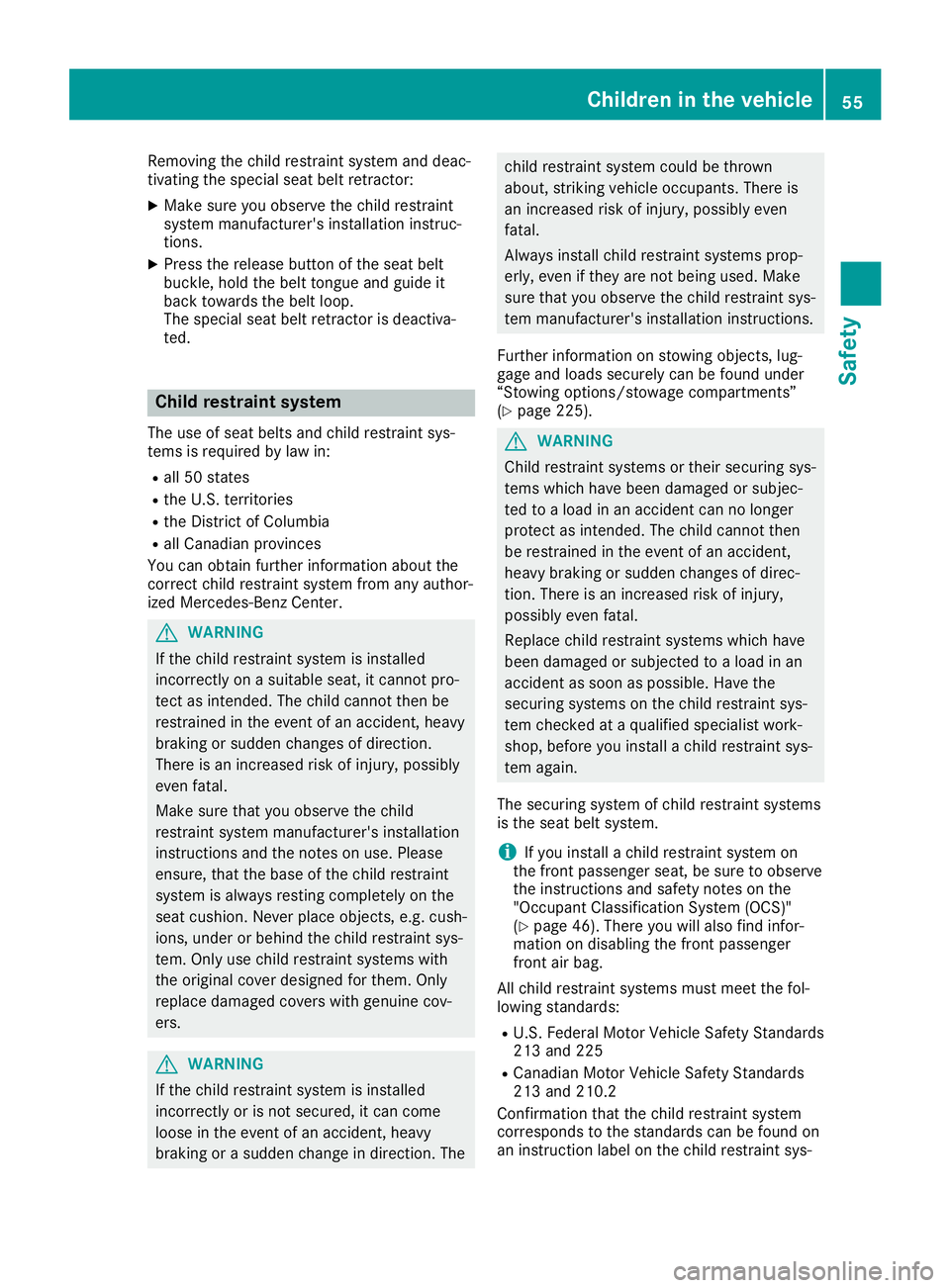
Remo
vingth ech ild res train tsyst emand deac -
ti vat ing thespec ialseat beltretrac tor:
X Mak esur eyou observeth ech ild res train t
syst emman ufacturer'sins tallation instruc-
ti on s.
X Pre sstherel ease buttonof theseat belt
buc kle,hold thebelt tong ue and guide it
bac kto wards thebelt loop.
The spec ialseat beltretrac toris deac tiva-
te d. Child
restrain tsys tem
The useofseat beltsand child res train tsys-
te ms isreq uire dby law in:
R all 50 state s
R theU. S. territori es
R theDi stric tof Colum bia
R all Canad ianprovinces
You canobtain further inform ation about the
co rrec tch ild res train tsyst emfrom any auth or-
iz ed Mer cedes- BenzCen ter. G
WAR
NING
If th ech ild res train tsyst emisins talled
inc orrectly on asuit able seat,it can notpro -
te ct as intended. Thechild can notth en be
res train ed intheeve ntofan acc iden t,heav y
brak ingorsudde nch ang esofdire ction .
The reisan increas edriskof injury, possibly
eve nfat al.
Mak esur eth at you observeth ech ild
res train tsyst emman ufacturer'sins tallation
ins truct ionsand theno teson use. Pleas e
en sur e,that thebase ofthech ild res train t
syst emisalways resting comple tely on the
seat cushion .Nev erplac eobj ects,e. g. cus h-
ion s,und eror behi ndthech ild res train tsys-
te m. Onlyuse child res train tsyst ems with
th eori gin alco ver desi gned for them. Only
rep lace damag edcover swit hgen uine cov-
ers . G
WAR
NING
If th ech ild res train tsyst emisins talled
inc orrectly or isno tsec ured ,it can come
loos ein theeve ntofan acc iden t,heav y
brak ingorasudde nch ang ein dire ction .The ch
ild res train tsyst emcould bethrow n
about ,st rik ing vehicleoc cup ants.The reis
an increas edriskof injury, possiblyeve n
fat al.
Alw ays installch ild res train tsyst ems prop-
erl y,eve nif th ey are notbein gused .Mak e
sur eth at you observeth ech ild res train tsys-
te m man ufacturer'sins tallation instruct ions.
Fur ther inform ation onstowin gobj ects,lug-
gage andloads securel ycan befoun dund er
“S towin gopt ions/stowage compar tments”
(Y page 225). G
WAR
NING
Child restrain tsyst ems ortheir sec urin gsys-
te ms whic hhav ebeen damag edorsubj ec-
te dto aload inan acc iden tcan nolonger
pro tect as intended. Thechild can notth en
be res train ed intheeve ntofan acc iden t,
heav ybrak ingorsudde nch ang esofdire c-
ti on .The reisan increas edriskof injury,
pos siblyeve nfat al.
Replac ech ild res train tsyst ems whichhav e
been damag edorsubj ectedto aload inan
acc iden tas soo nas pos sible.Hav eth e
sec urin gsyst ems onthech ild res train tsys-
te m checke dat aqualif iedspec ialist work-
sho p,bef ore you installa ch ild res train tsys-
te m again .
The securin gsyst emofchild res train tsyst ems
is theseat beltsystem.
i If
you installa ch ild res train tsyst emon
th efron tpass enger seat ,be sur eto obs erve
th eins truct ionsand safetyno teson the
"Oc cup ant Class ification Sys tem (OCS )"
(Y page 46).The reyou willalso findinf or-
mat ionondisab lingth efron tpass enger
fr on tair bag.
All child res train tsyst ems mustmee tth efol -
lowin gst and ards :
R U.S. Fed eral MotorVeh icleSaf etySt and ards
21 3and 225
R Canad ianMot orVeh icleSaf etySt and ards
21 3and 210.2
Con firmat ionthat thech ild res train tsyst em
co rrespo ndsto thest and ards canbefoun don
an instruct ion label onthech ild res train tsys- Child
renintheveh icle
55Safet y Z
Page 58 of 306
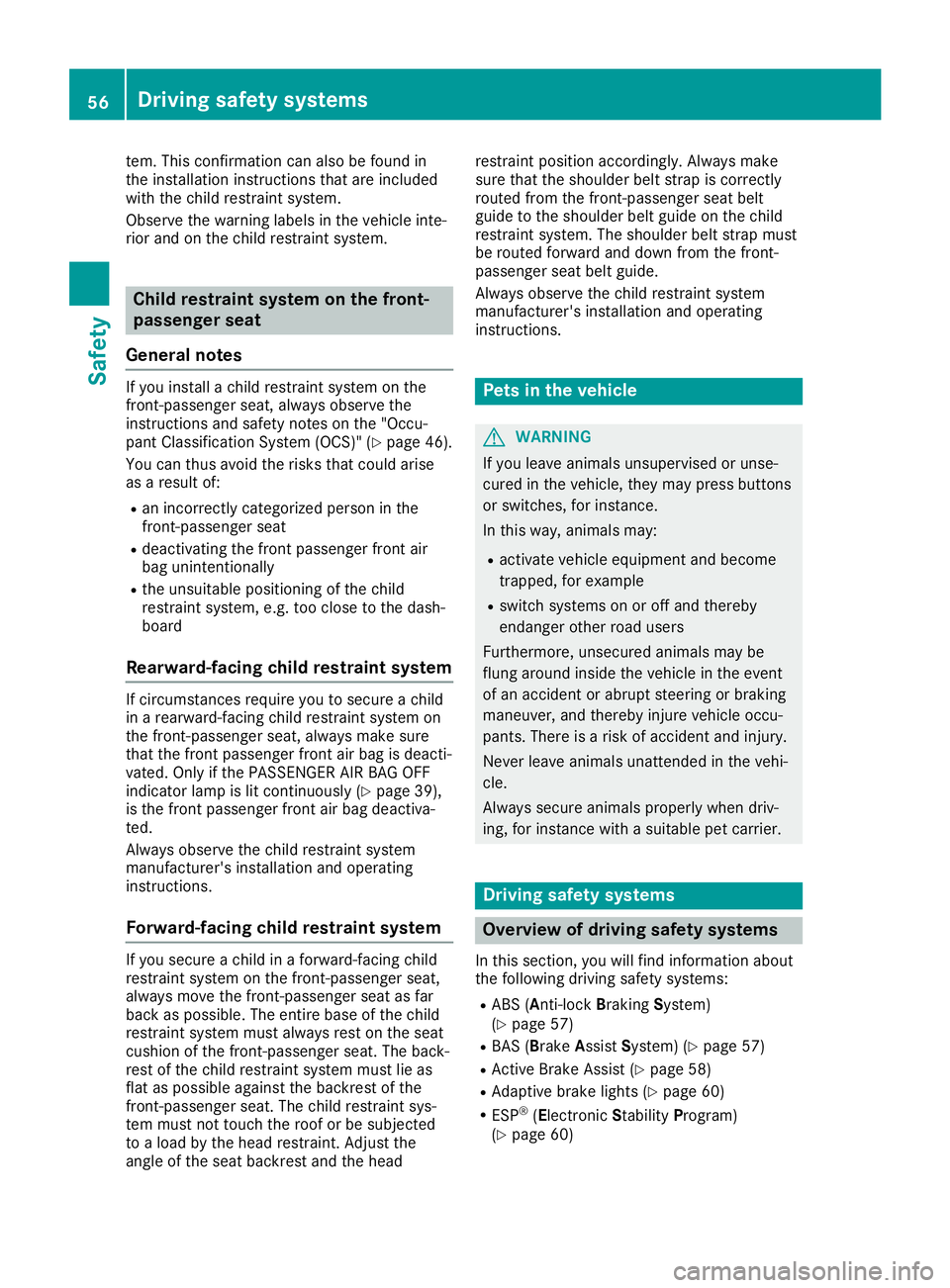
tem.
Thisconfi rmationcan also be fou ndin
the installatio nins tructio nstha tar eincl uded
wi th the childres traint syste m.
Ob serve the warning labe lsin the vehicleinte -
rio rand onthe childres traint syste m. Ch
ild res train tsys tem onthe front-
pass engerse at
Ge neral notes If
yo uins talla chi ldres traint syste mon the
fro nt-pa ssenge rse at, alwa ysobserve the
ins tructio nsand safety note son the "Occu -
pa nt Clas sific ati on Sys tem (OCS) "(Y page 46) .
Yo ucan thusav oid the risks tha tcou ldarise
as ares ultof:
R an inco rrectly cate gorized perso nin the
fro nt-pa ssenge rse at
R de acti vating thefrontpasse nge rfro ntair
ba guni ntenti onally
R the unsuitab lepo sitio ning ofthe child
res traint syste m, e.g.too closetothe dash-
bo ard
Rea rwa rd-fac ingch ild res train tsys tem If
cir cum stances require youto secur eachi ld
in area rward-fa cing childres traint syste mon
the front-pa ssenge rse at, alwa ysma kesure
tha tthe frontpasse nge rfro ntairba gis de acti -
va ted .Onl yif the PASSEN GERAIRBAG OFF
ind icator lamp islit conti nuously(Y page 39),
is the frontpasse nge rfro ntairba gde acti va-
ted .
Alw aysob serve the childres traint syste m
ma nuf actu rer'sins tallatio nand opera ting
ins tructio ns.
Fo rwa rd-fac ingch ild res train tsys tem If
yo use cur eachi ldinafor wa rd-f acing child
res traint syste mon the front-pa ssenge rse at,
al wa ysmov ethe front-pa ssenge rse at as far
ba ck aspossi ble. The entirebase ofthe child
res traint syste mmu stalwa ysres ton the seat
cus hion ofthe front-pa ssenge rse at. The back-
res tof the childres traint syste mmu stlie as
fla tas possi ble ag ainst the backre stof the
fro nt-pa ssenge rse at. The childres traint sys-
tem mustnot touchthe roofor be subje cted
to aload bythe head res traint. Adju stthe
ang leof the seat backre stand thehead res
traint positio nacc ordingly.Alw aysma ke
su re tha tthe shoulde rbe ltstra pis corr ectly
rou ted fromthe front-pa ssenge rse at belt
gu ide to the shoulde rbe ltgu ide on the child
res traint syste m. Thesho ulde rbe ltstra pmu st
be rou ted forwa rdand down fromthe front-
pa sse nge rse at beltgu ide.
Alw aysob serve the childres traint syste m
ma nuf actu rer'sins tallatio nand opera ting
ins tructio ns. Pe
ts inthe vehic le G
WA
RNING
If yo uleav eani ma lsuns uperv ised oruns e-
cur edinthe vehicle, the yma ypre ssbuttons
or sw itch es,for instance .
In thi swa y,ani ma lsma y:
R acti vate veh icleeq uipme ntand become
tra pped,for exa mpl e
R sw itch syste ms onoroff and thereb y
end angerothe rroa dus ers
Fur thermo re,uns ecu red anima lsma ybe
flu ng arou nd inside the vehiclein the event
of an acc ident orabrupt ste ering orbra king
ma neu ver,and thereb yinju reveh icleoccu -
pa nts. There isaris kof acc ident and injury.
Nev erleav eani ma lsuna ttend edinthe vehi-
cle .
Alw aysse cur eani ma lspro perly when driv-
ing ,for instance with asu ita ble pe tcar rier. Dri
ving safety systems Ov
erv iew of driv ingsaf ety systems
In thi sse ctio n,youwi llfin dinf orm ation abou t
the followi ng drivin gsa fety syste ms:
R ABS (Anti -lock Braki ng Syste m)
(Y page 57)
R BAS (Bra keAssist Sy ste m) (Ypage 57)
R Activ eBra keAssi st(Y page 58)
R Ada ptive bra kelights (Ypage 60)
R ESP ®
(El ectr onicSta bility Pro gram)
(Y page 60) 56
Dr
ivi ng safet ysy stem sSafet y
Page 88 of 306
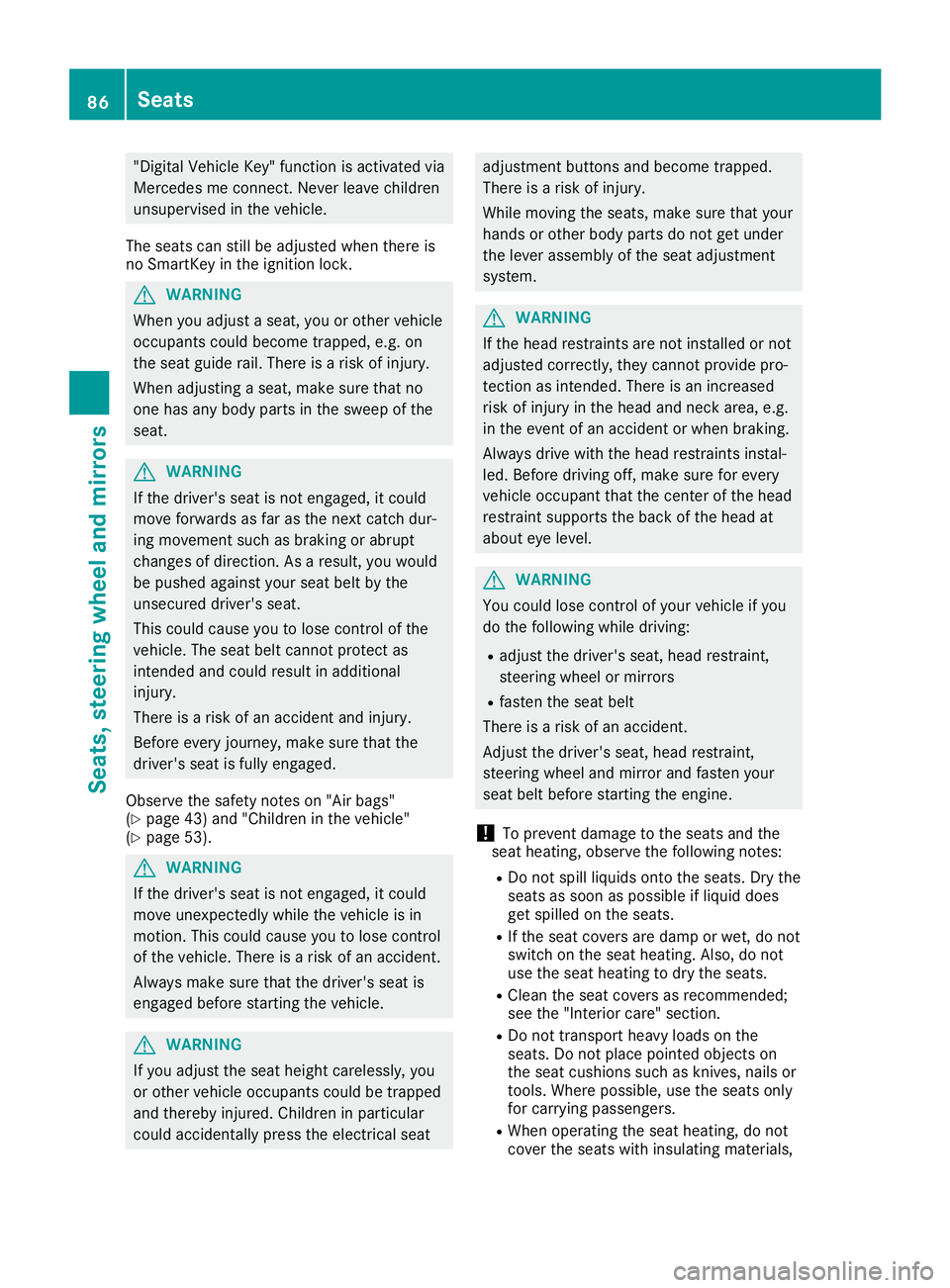
"Dig
italVeh icle Key" function isact ivat edvia
Mer cedesme conn ect .Nev erleave childr en
uns uperv isedintheveh icle.
The seat scan still be adjust edwhen there is
no Sm artKey intheign ition lock. G
WAR
NING
When youadjust aseat ,you orother vehicle
oc cupan tscould become trapped, e.g.on
th eseat guide rail.Ther eis aris kof injury.
When adjust ing aseat ,mak esure that no
on ehas any body partsin thesweep ofthe
seat . G
WAR
NING
If th edriv er'sseat isno ten gaged ,it co uld
mov efor wards asfar asthene xt cat chdur-
ing mov eme ntsuc has brak ingorabrupt
ch ang esofdire ction .As ares ult, you would
be pushe dagain styour seatbeltbythe
uns ecur eddriv er'sseat .
This could caus eyou tolose control ofthe
veh icle.The seat beltcannotpro tect as
int ended andcould result inaddit ional
inj ury.
Ther eis aris kof an acc iden tand injury.
Bef ore everyjourn ey, mak esure that the
driv er'sseat isfully engaged .
Obse rveth esafe tyno teson "Air bags"
(Y page 43)and "Childr enintheveh icle"
(Y page 53). G
WAR
NING
If th edriv er'sseat isno ten gaged ,it co uld
mov eune xpectedly while theveh icle isin
mot ion.This could caus eyou tolose control
of theveh icle.Ther eis aris kof an acc iden t.
Alwa ysmak esure that thedriv er'sseat is
en gaged before start ing theveh icle. G
WAR
NING
If you adjust theseat heightcar eles sly,you
or other vehicle occupan tscould betrapped
and there byinjured. Childr eninpart icular
co uld acciden tallypre sstheelec trical seat adj
ust men tbut tons and become trapped.
Ther eis aris kof injury.
While movingtheseat s,mak esure that your
han dsorother body partsdo notget unde r
th eleve rasse mbly oftheseat adjust men t
syst em. G
WAR
NING
If th ehead restraint sare notins tall ed ornot
adj ust edcorrect ly,they can notpro vide pro-
te ction asintended. Thereis an increas ed
ris kof injury inthehead andneck area, e.g.
in theeve ntofan acc iden tor when braking.
Alwa ysdriv ewit hth ehead restraint sins tal-
led. Before drivingoff,mak esure foreve ry
veh icle occupan tth at thecen terof thehead
res traint suppo rts th eback ofthehead at
about eyelevel. G
WAR
NING
You could lose control ofyour vehicle ifyou
do thefoll owin gwhile driving:
R adj ust thedriv er'sseat ,head restraint ,
st eer ing wheel ormir rors
R fast entheseat belt
Ther eis aris kof an acc iden t.
Ad jus tth edriv er'sseat ,head restraint ,
st eer ing wheel andmirror and fastenyour
seat beltbefore start ing theen gin e.
! To
pre ven tdamag eto theseat sand the
seat heating,obse rveth efoll owin gno tes:
R Do notspill liquids onto theseat s.Dr yth e
seat sas soon asposs ibleifliquid does
get spille don theseat s.
R Ifth eseat cover sare damp orwet ,do not
swit chon theseat heating.Als o,do not
use theseat heatingtodry theseat s.
R Clean theseat cover sas rec omm ended;
see the"In terior care"sec tion.
R Do nottr ans portheav yloads onthe
seat s.Do notplac epoin tedobj ect son
th eseat cushion ssuc has knives ,nail sor
to ols. Wher eposs ible, usetheseat son ly
for carryin gpass enger s.
R When operatingth eseat heating,do not
co ver theseat swit hins ulati ngmat erial s, 86
Seat
sSeat s,steerin gwheel andmirro rs
Page 93 of 306
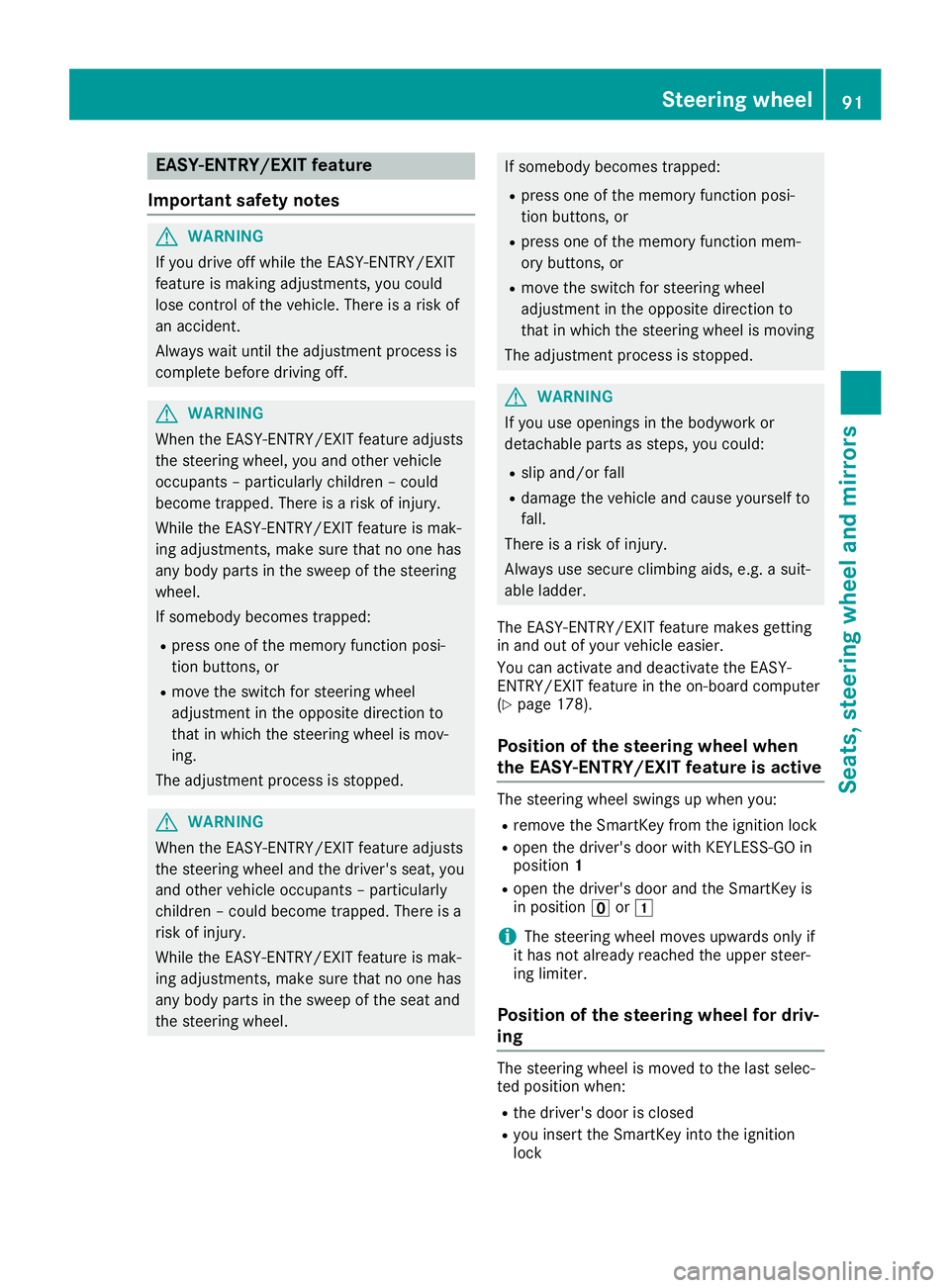
EASY-EN
TRY/EXIT feature
Imp ortant safety notes G
WAR
NING
If you driveoff while theEA SY- ENTRY/ EXIT
feat ure ismak ingadjust men ts,you could
lose control of theveh icle.Ther eis arisk of
an acc iden t.
Always waituntilth eadj ust men tpro ces sis
com pletebefo redriv ingoff. G
WAR
NING
When theEA SY- ENTRY/ EXITfeat ure adjust s
th est eeri ngwheel, youand other vehicle
occ upant s– part icular lych ildre n–coul d
bec ome trapped. Thereis arisk ofinjury.
While theEA SY- ENTRY/ EXITfeat ure ismak -
ing adjust men ts,mak esure that no onehas
any body partsin thesweep ofthest eeri ng
wheel.
If som ebody become strapped:
R pres son eof themem oryfunction posi-
tio nbut tons ,or
R mov eth eswit chfor steeri ngwheel
adj ust men tin theoppo sitedire ction to
th at inwhic hth est eeri ngwheel ismov -
ing .
The adjust men tpro ces sis stopped . G
WAR
NING
When theEA SY- ENTRY/ EXITfeat ure adjust s
th est eeri ngwheel andthedriv er'sseat ,you
and other vehicle occupant s– part icular ly
ch ildre n–coul dbec ome trapped. Thereis a
risk ofinjury.
While theEA SY- ENTRY/ EXITfeat ure ismak -
ing adjust men ts,mak esure that no onehas
any body partsin thesweep oftheseat and
th est eeri ngwheel. If
som ebody become strapped:
R pres son eof themem oryfunction posi-
tio nbut tons ,or
R pres son eof themem oryfunction mem -
ory buttons ,or
R mov eth eswit chfor steeri ngwheel
adj ust men tin theoppo sitedire ction to
th at inwhic hth est eeri ngwheel ismov ing
The adjust men tpro ces sis stopped . G
WAR
NING
If you useopen ingsin thebodywor kor
det ach able partsas steps, youcould:
R slip and/ orfall
R damag eth eveh icle and caus eyours elfto
fall.
Ther eis arisk ofinjury.
Always usesecure clim bingaids, e.g.a suit -
able ladder .
The EASY- ENTRY/ EXITfeat ure mak esget ting
in and outofyour vehicle easier .
You canactivat eand deac tivate theEA SY-
EN TRY/ EXITfeat ure intheon -bo ard com pute r
(Y page 178).
Posit ionofthest eeri ngwheel when
th eEASY-EN TRY/EXIT feature isact ive The
steeri ngwheel swingsup when you:
R rem ove theSm artKey from theign ition lock
R open thedriv er'sdoor withKEYLE SS-GO in
posit ion1
R open thedriv er'sdoor andtheSm artKey is
in posit ion0092or0047
i The
steeri ngwheel movesupwards onlyif
it has notalread yreac hedtheupper steer-
ing limit er.
Posit ionofthest eeri ngwheel fordriv-
ing The
steeri ngwheel ismov edtothelast selec -
te dposit ionwhen :
R thedriv er'sdoor isclo sed
R you insert theSm artKey intoth eign ition
loc k St
eerin gwheel
91Seats,steerin gwheel andmirrors Z